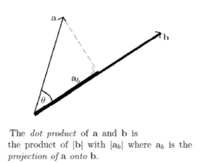The following shows two examples of vector multiplication to get the dot product. It's easy enough to understand the math, but what use/value is there for the single number that results? What does the answer (2 in the first example and the 4 in the second example) represent? I know it's used later to find the angle between the two vectors, but is there any application of the dot product itself? Can we geometrically or algebraically use the '2' and the '4' dot products to tell us anything else about the vectors? When you add, subtract, or multiply a vector by a scalar, the vector is transformed somehow. But I'm having trouble understanding the meaning of the dot product. Any help would be appreciated.



